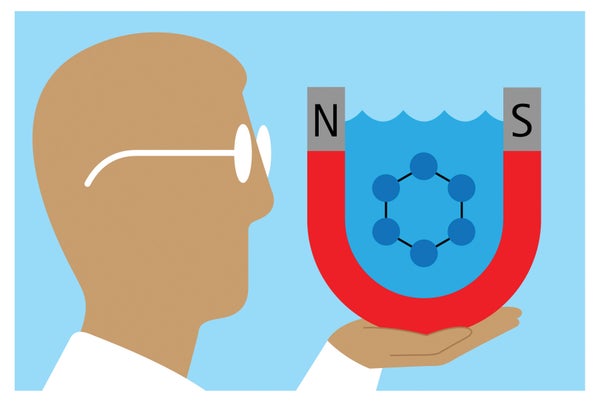The fact that like charges repel and opposites attract is basic electromagnetism. But for decades scientists have occasionally made a counterintuitive, and controversial, observation: similarly charged particles can sometimes also attract one another when dispersed in a liquid solvent such as water or alcohol.
Researchers now propose in Nature Nanotechnology that this phenomenon arises from the solvent’s molecular nature. The team observed that negatively charged silica particles pulled together and formed hexagonal clusters in water, and positively charged silica variants were mutually attracted in alcohol. Modeling water molecules’ behavior near charged particles helped to reveal why.
In previous experiments, researchers considered a fluid to be one continuous substance, but this ignores the influence of its tiny atomic building blocks. Water, for instance, is made up of individual molecules that are dipoles—you can think of them as having more charge on one side than on the other, like a battery, says University of Oxford chemist and study co-author Madhavi Krishnan. And water molecules prefer to bond with other water molecules, so when they’re near a suspended particle they tend to point their two slightly positive hydrogen atoms toward the rest of the liquid and their slightly negative oxygen atom toward the particle.
On supporting science journalism
If you're enjoying this article, consider supporting our award-winning journalism by subscribing. By purchasing a subscription you are helping to ensure the future of impactful stories about the discoveries and ideas shaping our world today.
As negatively charged silica particles in water approach one another, they experience an effect called charge regulation, whereby the repulsion between them pulls nearby protons onto each particle’s surface, reducing the particles’ negative charge. That then weakens their repulsion from the water’s oxygen atoms, too, a phenomenon that intensifies as the silica particles move toward one another. This change draws the silica particles together from about a micron away.
The team observed the opposite effect in alcohol, because its molecules prefer to steer the other way at a particle’s surface: positively charged particles suspended in alcohol pull together instead. A solvent’s acidity also influences charge and thus whether particles in it form clusters.
Scientists were long uncertain whether such strange attraction was an experimental artifact or a real physical phenomenon, Krishnan says. Critics have disputed previous observations of this effect citing optical distortions, weak particle attraction, or hydrodynamic forces causing particles to drift together. “This paper solves a mystery that has been out there for 20-plus years,” says Jay T. Groves, a chemist at the University of California, Berkeley. “It’s very thorough, and I think [it’s] indisputable that this effect is a property of the solvent.”
This finding’s potential uses are “limited to one’s own creativity,” Krishnan says. The team’s future work will investigate particle behavior in other solvents, as well as applications to fields such as biology: how molecules—many of which carry lots of electrical charge—organize themselves in cells.
